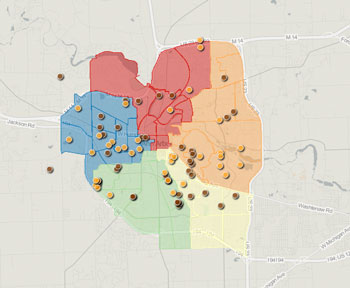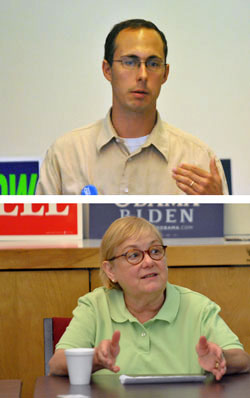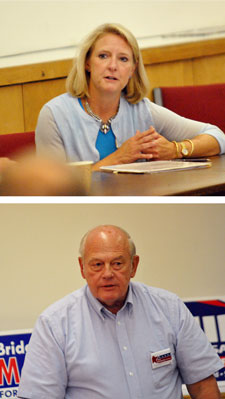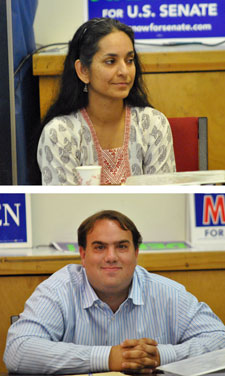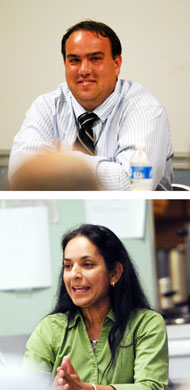Ward 5 City Council: Studying, Listening
On July 22, 2012, a hot summer Sunday afternoon, more than 35 people gathered at the Peace Neighborhood Center to hear Ward 5 Democratic primary candidates for Ann Arbor city council respond to questions.

Vivienne Armentrout and Chuck Warpehoski as seen through the viewfinder of a video camera that recorded the July 22, 2012 Ward 5 Democratic forum. (Photos by the writer.)
Chuck Warpehoski and Vivienne Armentrout are contesting the seat that will be open because sitting councilmember Democrat Carsten Hohnke is not seeking a third term. The winner of the Aug. 7 primary will face Republican Stuart Berry in November’s general election.
The format of the forum – hosted by the Ward 5 Democratic Party organization, and moderated by Gus Teschke – allowed Warpehoski and Armentrout to offer a clear contrast to prospective voters. They had four minutes to respond to each question, with an opportunity for a rebuttal and additional follow-up by the person who’d submitted the question.
Both Armentrout and Warpehoski were obviously knowledgeable about the range of topics they were asked to address by questioners.
The contrast emerged mainly in terms of the types of themes they emphasized, rather than differences in specific policy points – but some policy differences emerged as well. Throughout her remarks, Armentrout stressed her experience, knowledge and study of policy. For example, she introduced broad policy issues into the topic of the Ann Arbor Downtown Development Authority’s administration of the city’s public parking system – in part by calling the parking system the “parking utility,” drawing a parallel between that and utilities like water or electric service. And she explained her thoughts on providing affordable housing and human services by appealing to her understanding of the history of federal grant funding to the city of Ann Arbor.
On that same topic, responding to a question from local activist Alan Haber, Warpehoski said he would spearhead – and is already spearheading – an effort to replace 100 units of affordable housing that were lost when the old YMCA building was condemned and demolished. His effort on that issue is a function of his day job as director of the Interfaith Council for Peace and Justice. He frequently appealed to the skills he uses in that job – the notion of listening, and working to bring people together for the common good. He described several times the kinds of conversations he’s been having with residents of the ward as he goes door-to-door canvassing, relating some of the specific stories from each neighborhood. He pointed to those kinds of conversations as the kind that he’d like to continue if he’s elected, as part of an effort to hear all the voices in the community.
Warpehoski fielded some pointed questions from attendees, including one about his endorsement by mayor John Hieftje. Did that mean he’d favor decision-making behind closed doors? Warpehoski told the audience he’d made clear to Hieftje that if elected, he’d push the mayor on two issues: public process and the independence of board and commission appointments. Responding to another audience question, Warpehoski also said he’d recuse himself from votes if it were appropriate to do that – due to his wife’s job as director of the getDowntown program.
Warpehoski was also challenged to account for his use of the phrase “transit opponents” in an op-ed piece he’d written about the Ann Arbor Transportation Authority’s effort to expand its governance and service area to a countywide region. He explained his use of that phrase by saying you have to look at people’s actions and whether those actions actually support transit – drawing an analogy to someone who says they are for “health” but who sits on the couch eating Kentucky Fried Chicken all day.
Support for a current countywide transit proposal was one clear policy difference between the two candidates. Warpehoski supports the framework embodied in a four-party agreement – between Ann Arbor, Ypsilanti, Washtenaw County and the Ann Arbor Transportation Authority – while Armentrout does not. At its Aug. 1 meeting, the Washtenaw County board of commissioners is expected to give final approval for that agreement, which the other three parties have already ratified.
After the jump, more detail is presented on questions and responses from the two candidates. [Full Story]




